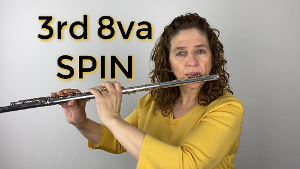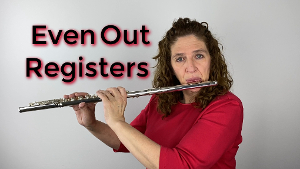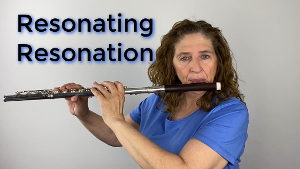How many of you feel like your third octave just does not have the same kind of resonance and excitement that perhaps your second and your first octave do? Learning how to “spin” your notes is one way to add that excitement to your high notes. We all need to work harder at our third octave, but there’s some issues with working up there.
Embouchure Tightens
Number one, if you do it too long, you can get really too tight in your embouchure. So, we don’t recommend working on your third octave for a long space of time because you don’t want to get in the habit of getting tight. And while I’m always pretty loose and I don’t normally have any trouble with being tight in my third octave, I’ve had some pieces where the tessitura is up there in the octave, and I need to work out some fingering or technical issues. I have discovered by trial-and-error that the longer I work up that high, the tighter my embouchure get. So, I limit my 3rd octave practice to 20 minutes or less.
So, if you experience that too, as soon as you realize that you are tightening, then just stop what you are doing, do some low work to loosen yourself up, and then you’ll be ready to work up there again. You just have to discover what that timeframe is for you and then, work with that in mind.
Hearing Loss
Now the other thing is when you work in your third octave that you must be aware of is that you can damage your ears. So, you want to use ear protection. There are those drugstore kinds that are little foam things and you put them in your ear, and they work. I’m not an audiologist, but you know, people use them, and I have used them for piccolo. Right now, I have the ones that I got at a flute convention. There was an actual hearing audiologist there that made them and fit them to my ears. So, I hear better with these specialized ones, but it still filters out the higher harmonics so I can hear what I am playing without damaging my hearing. So be careful about that and make sure you’re using ear protection.
Start Loose
All right, so what do you do in that third octave? Well, one of the big things is almost all the time is our embouchure is too tight. And yes, I said that already. Don’t play with a tight embouchure. But if you are starting with a tight embouchure because you haven’t learned how to loosen it up, that is the first thing you need to do: start with a much looser embouchure.
Yes, it’s much tighter than if I am playing in my first octave going down to a low C. It’s really loose here and going up into that third octave, yes, it’s got to be firm. And I like to use the word firm, not tight, because tight connotes, well, something not good and firm just means I have a firm foundation on what’s happening up here.
When I teach my students, I never talk about being firm there because I think you automatically do what is necessary to at least get the note to come out. But you may need to learn that you can get your high notes to come out without having to be tight.
Stomach Punch
So, I like to use what I call the stomach punch. If you actually got punched in the stomach all of your air would come out really fast. So, to do this move, you are going to mimic being punched in the stomach and force out a burst of air. You do this with a high note and a very loose embouchure. The idea is to see if you can get a high note, like a high G without a tight embouchure.
Once you get a note you like, try to hold that note while keeping your embouchure loose. Your lips cannot be flabby, they need to be somewhat firm. When you practice this enough, you realize that you can get a high note to come out without having to be tight!
Add Support
Now, once I have that loosened up embouchure, the next thing is to make sure you have support. I am not going to go into detail about support because I have plenty of other blogs and videos about support. But you must make sure that your muscles are tight, and they are pushing up on that high note. When you do that, it gives you the liberty to loosen your embouchure. Then with really tight support, and a loose embouchure, I can add some air in my cheek, which helps with intonation, and I can make that be a nicer rounder sound.
Get Spin
Now when we are talking about that third octave, we like to talk about it with spin. I can put vibrato on. But what I really want to think about is up there in that register to have more spin. Sopranos talk about having spin on their high notes. Because they are so high, we need to have that movement or else the sound is really harsh. So, I’m going to start off with a really short tone and I’m just gonna jiggle it and really just move my voice box.
Moving the vibrato faster is what sopranos call that spin. You don’t want to call it vibrato up there for whatever reason. But I like that term because when I think of vibrato, I usually think of it something a little bit slower. If I am doing a really short note, I can have that spin. If I’m going to hold it, it’s a little bit, less as less fast. But it’s still what I would call a spin.
Really tight. Each one of those notes I’m pushing with my stomach. So, my stomach went tight, relaxed tight, relaxed tight, relax to help me push up there and keep this open.
Big Inside
Now to get spin on that third octave note, I also want to be really big inside. It doesn’t matter the size of my opening or teeth spacing, but inside needs to be a cavern. This is because I want that air to echo behind my sinus cavity.
The way you achieve this is to put your tongue down and your soft pallet up. This gives that air a free space to come out without any constriction. If you think you are playing with a tight throat, you will never get the spin you are looking for on that third octave note. The throat has to be open and big and the airstream unobstructed as it comes out. Now, if you keep your soft palate up and your tongue down when you are playing, that air gets to echo behind your sinus cavity as it is coming out, giving you the resonance that you are looking for.
So, what you think about when you want third octave spin is first start off with a loose embouchure, then make sure you have support pushing up on your high notes. Then jiggle that tone. Have a cavern inside so that tone can resonate. This is how your get spin on your third octave notes.
Experiment with this and let me know how it goes. And don’t forget your ear protection.
Have fun!
DoctorFlute
Watch me demonstrate this:
Getting Spin on Your Third Octave Notes – FluteTips 171

Failure to Plan for Your 3rd 8va Notes is a Plan to Fail – FluteTips 181

Loosening Your Embouchure While You Are Playing – FluteTips 165

Evening Out Your Registers – FluteTips 169

The Importance of Your Throat in Tone Production – FluteTips 157

Resonate to Improve Your Tone – FluteTips 178

